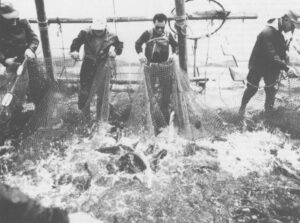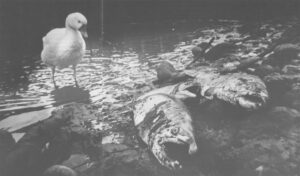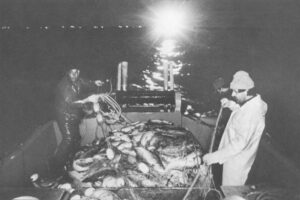Natalie Fobes
- 1986

Fellowship Title:
- Pacific Salmon and their struggle to survive
Fellowship Year:
- 1986

The Promise of The Future
Salmon culture is a phrase buzzing through the seafood industry, terrifying fishermen, titillating restaurateurs and seducing investors. Raising salmon specifically for harvest may change the way we think about these incredible creatures. The potential is there to produce low-cost, high-protein food. The potential is there but not yet realized. The smart money says it will be. It was only a matter of time before the salmon’s instinct to return to its natal rivers was exploited. Why not ranch them? people asked. Rear them in a hatchery to smolt size, send them out to graze in the ocean and, when the adult fish come back in three to four years, harvest them. It makes more sense than chasing salmon all over the ocean as commercial fisherman do now. The lifecycle of the Salmon Or maybe we can farm them, they continued. Raise salmon in net pens in saltwater bays as well as freshwater rivers and lakes until a restaurant or broker puts in an order. Harvest the fish and deliver them to the customer. Salmon on

The Struggle to Survive
SEATTLE–It was a disaster. The banks of Seattle’s Duwamish River were covered with carcasses of adult salmon returning to spawn. Jaws open, eyes intact, thousands of dead fish had been in the mud for twenty hours undisturbed by the myriad of birds which, under normal circumstances, should have devoured much of the flesh during that time. This was the first clue that toxic chemicals were involved. The second came from eyewitnesses of the Saturday afternoon kill last September. Fishermen hip deep in the river’s tidal currents watched, bewildered, as fish burst from the water and beached themselves on the bank. A toxic reaction, said biologists. Not knowing how to report the frenetic activity, sportsmen called 911, the county-wide emergency number, and the State Patrol. No one, neither private citizen nor state employee, called the Department of Ecology’s (DOE) toxic spill hotline. Thirteen hours later, DOE personnel began their investigation. Evidence needed to ascertain the source of the spill had disappeared during those intervening hours. Whatever toxin might have been in the water had since been

Cowboys of the Sea
Bristol Bay, Alaska–The shallow reach of the Bering Sea crashes between the shoulder and the arm of Alaska’s Aleutian mountain range. The tundra, receding in waves from the ocean, is flecked with small ponds two feet deep. White in winter, pale green in summer. the plains roll on almost a hundred miles with only an occasional stand of black spruce piercing the horizon. Twenty trumpeter swans, almost extinct in the lower 48, turn their eyes skyward, then return to feeding. A brown bear and her two cubs meander undisturbed along the paths connecting one tundra pond to another. A small herd of caribou dig through sweet smelling grasses, happy to be done with lichen. Come November, hundreds of their kin will join them to migrate to their winter grounds. For ten months a year, the sun skirts the landscape casting few shadows from human forms. Few people live on the western edge of the western world in winter and those that do wait within themselves for spring. When the snow disappears for the last time

Homeward Hearts: A Story of Pacific Salmon
The cool evening breezes have not yet evaporated the remainder of the sweat between the spectators’ shoulder blades. Shielding their eyes from the sun, they stare transfixed at the rushing water before them. “Yea! Looky there.” Twenty-one heads swivel in time to catch a shadow playing across the water. “All right!” Forty-two eyes glimpse a flicker of fin. Beer bottles and popcorn are passed from hand to hand, from Chevy to Ford pickup. VW to Bonneville. This is the best show playing in Toppenish, Wash., this night in May. There’s a collective gasp as nineteen pounds of streamlined muscle bursts from the foam, suspended in the spotlight of the setting sun. The spring chinook, the king salmon have returned to the Yakima River. Once more the fish have survived the precarious journey home only to procreate and die. While the great mystique of the salmon is appreciated by those watching, most don’t realize that the fish represent between .06 and 2.5 percent of the millions of eggs laid four and five years ago in this
